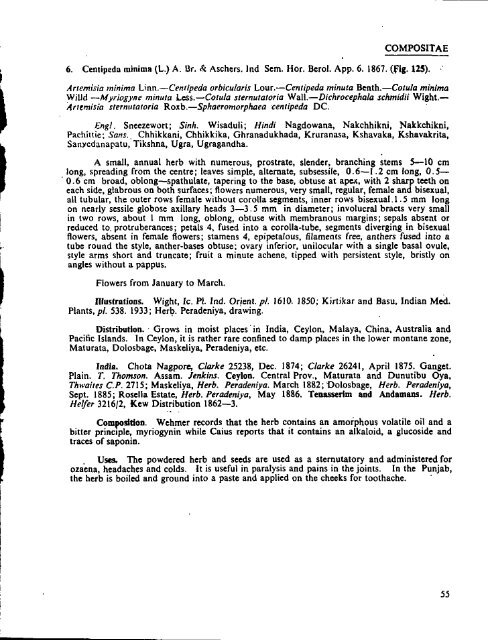,r\/*> - National Science Foundation
,r\/*> - National Science Foundation
,r\/*> - National Science Foundation
You also want an ePaper? Increase the reach of your titles
YUMPU automatically turns print PDFs into web optimized ePapers that Google loves.
COMPOSITAE<br />
6. Centipeda minima (L.) A. Br. A Aschers. Ind Sem. HOT. Berol. App. 6. 1867. (Fig. 125).<br />
Artemisia minima Linn.—Centipeda orbicularis Lour.—Centipeda minuta Benth.—Cotula minima<br />
WilJd —Myriogyne minuta Less.—Cotula sternutatoria Wall.—Dichrocephala schmidii Wight.—<br />
Artemisia sternutatoria Roxb.—Sphaeromorphaea centipeda DC.<br />
Engl. Sneezewort; Sink. Wisaduli; Hindi Nagdowana, Nakchhikni, Nakkchikni,<br />
Pachittie; Sans. m Chhikkani, Chhikkika, Ghranadukhada, Kruranasa, Kshavaka, Kshavakrita,<br />
Sanycdanapatu, Tikshna, Ugra, Ugragandha.<br />
A small, annual herb with numerous, prostrate, slender, branching stems S—10 cm<br />
long, spreading from the centre; leaves simple, alternate, subsessile, 0.6—1.2 cm long, 0.5—<br />
0.6 cm broad, oblong—spathulate, tapering to the base, obtuse at apex, with 2 sharp teeth on<br />
each side, glabrous on both surfaces; flowers numerous, very small, regular, female and bisexual,<br />
all tubular, the outer rows female without corolla segments, inner rows bisexual. 1.5 mm long<br />
on nearly sessile globose axillary heads 3—3.5 mm in diameter; involucral bracts very small<br />
in two rows, about 1 mm long, oblong, obtuse with membranous margins; sepals absent or<br />
reduced to. protruberances; petals 4, fused into a corolla-tube, segments diverging in bisexual<br />
flowers, absent in female flowers; stamens 4, epipetaious, filaments free, anthers fused into a<br />
tube round the style, anther-bases obtuse; ovary inferior, unilocular with a single basal ovule,<br />
style arms short and truncate; fruit a minute achene, tipped with persistent style, bristly on<br />
angles without a pappus.<br />
Flowers from January to March.<br />
Illustrations. Wight, Ic. PI. Ind. Orient, pi. 1610. 1850; Kirtikar and Basu, Indian Med.<br />
Plants, pi. 538. 1933; Herb. Peradeniya, drawing.<br />
Distribution. Grows in moist places in India, Ceylon, Malaya, China, Australia and<br />
Pacific Islands. In Ceylon, it is rather rare confined to damp places in the lower montane zone,<br />
Malurata, Dolosbage, Maskeliya, Peradeniya, etc.<br />
India. Chota Nagpore, Clarke 25238, Dec. 1874; Clarke 26241, April 1875. Ganget.<br />
Plain. T. Thomson. Assam. Jenkins. Ceylon. Central Prov., Maturata and Dunutibu Oya,<br />
Thwaites CP. 2715; Maskeliya, Herb. Peradeniya. March 1882; Dolosbage, Herb. Peradeniya,<br />
Sept. 1885; Rosella Estate, Herb. Peradeniya, May 1886. Tenasserim and Andamans. Herb.<br />
Heifer 3216/2, Kew Distribution 1862—3.<br />
Composition. Wehmer records that the herb contains an amorphous volatile oil and a<br />
bitter principle, myriogynin while Caius reports that it contains an alkaloid, a glucoside and<br />
traces of saponin.<br />
Uses. The powdered herb and seeds are used as a sternutatory and administered for<br />
ozaena, headaches and colds. It is useful in paralysis and pains in the joints. In the Punjab,<br />
the herb is boiled and ground into a paste and applied on the cheeks for toothache.<br />
55
















